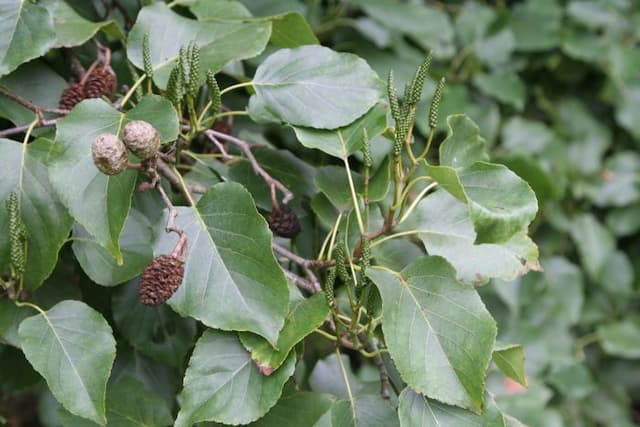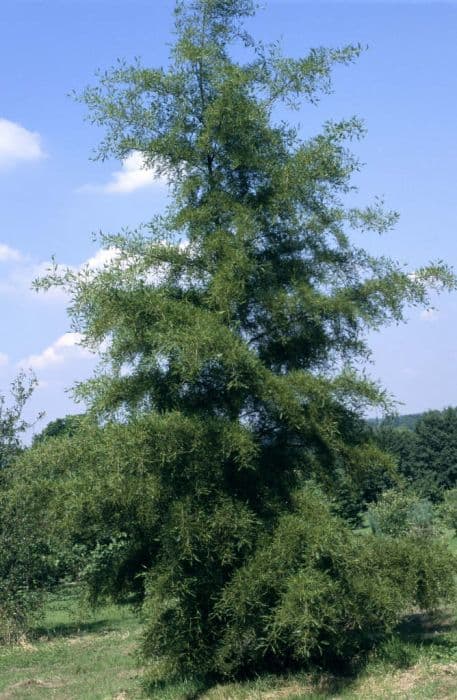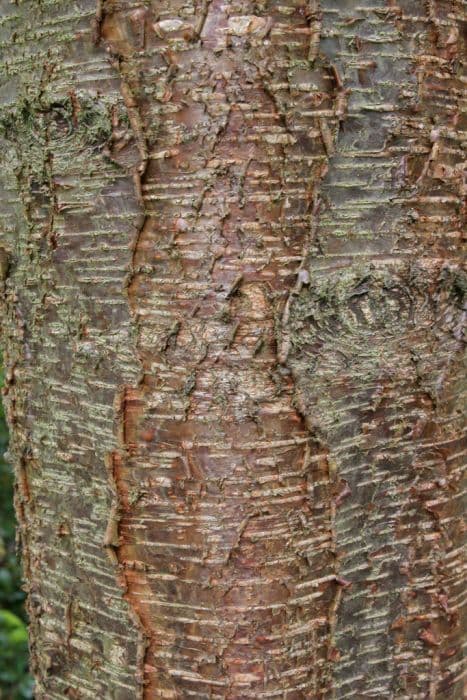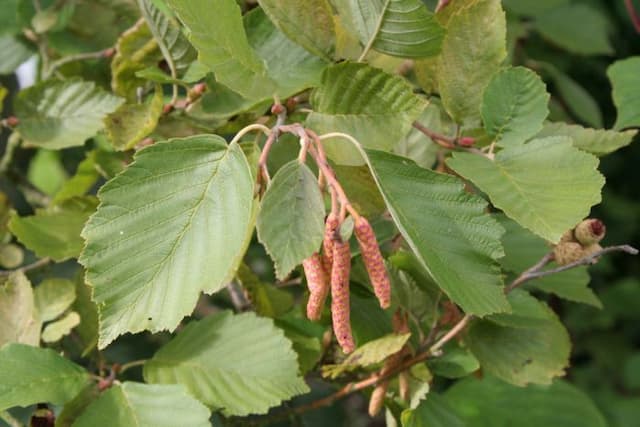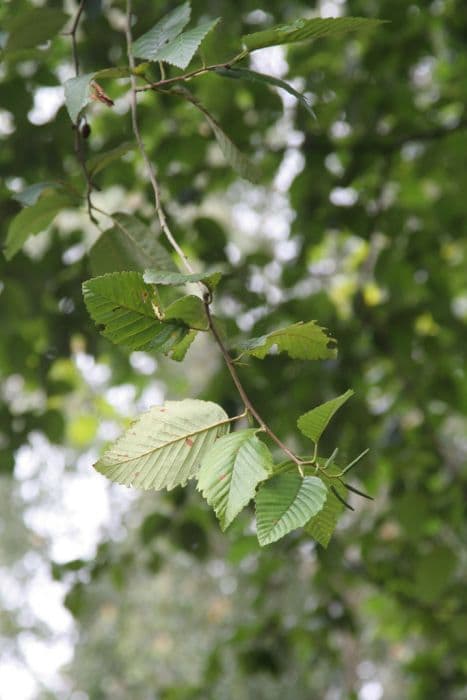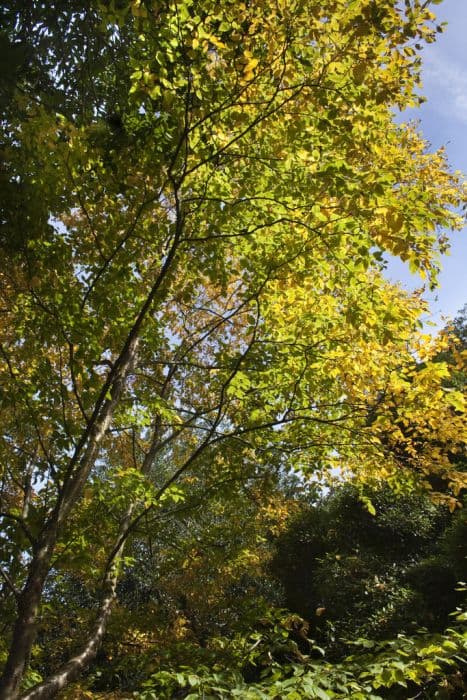Japanese hornbeam Carpinus japonica

ABOUT
C. japonica is a spreading deciduous tree of elegant appearance, with glossy, prominently veined leaves and conspicuous green fruiting catkins turning pale brown with maturity
About this plant
 Names
NamesFamily
Betulaceae
Synonyms
Japanese Hornbeam, Miyama Hana Katsura
Common names
Carpinus japonica.
 Characteristics
CharacteristicsLife cycle
Perennials
Foliage type
Deciduous
Color of leaves
Green
Height
20-30 feet (6-9 meters)
Spread
20-30 feet (6-9 meters)
Plant type
Tree
Hardiness zones
5
Native area
Japan
Benefits
 General Benefits
General Benefits- Ornamental Value: Carpinus japonica, commonly known as the Japanese hornbeam, adds aesthetic appeal to gardens with its attractive foliage and distinctive bark.
- Shade Provider: It can offer a cooling shade in residential and public landscapes during the hot summer months.
- Habitat for Wildlife: The tree can serve as a habitat for birds and other wildlife, providing shelter and possible nesting sites.
- Seasonal Interest: The plant exhibits seasonal changes that can include beautiful autumn leaf colors and interesting fruit structures, contributing to year-round visual interest.
- Erosion Control: Its root system can help stabilize soil and prevent erosion on slopes or in areas prone to runoff.
- Durable Wood: The wood of Carpinus japonica is hard and can be used for various woodworking projects, though it is not commonly exploited.
- Low Maintenance: Once established, it generally requires minimal care, making it suitable for parks and large gardens.
 Medical Properties
Medical PropertiesThis plant is not used for medical purposes.
 Air-purifying Qualities
Air-purifying QualitiesThis plant is not specifically known for air purifying qualities.
 Other Uses
Other Uses- Woodworking: The wood of Carpinus japonica, commonly known as Japanese hornbeam, is valued by craftsmen for its fine grain and workability, making it suitable for intricate woodworking projects such as furniture or musical instruments.
- Bonsai: This species is prized for bonsai due to its attractive foliage, smooth bark, and ability to be shaped and maintained in miniature form.
- Printing: The dense wood of the Japanese hornbeam can be used to make printing blocks, especially appreciated in traditional woodblock printing techniques.
- Ornamental Use: With its attractive leaves and overall shape, this tree is often planted in gardens and parks purely for aesthetic purposes.
- Tool Handles: The strength and resilience of Japanese hornbeam wood make it a good choice for handles of various tools, offering durability and a comfortable grip.
- Fuel: Despite it not being the most common use, the wood of Japanese hornbeam can be used as firewood for heating since it burns slowly and provides a steady source of heat.
- Natural Dyes: The bark of Japanese hornbeam can be used to extract tannins and produce natural dyes for textiles.
- Leaf Litter for Composting: The leaves, when decomposed, provide valuable nutrients to garden compost, contributing to soil fertility.
- Barrel Making: The wood's tight grain and resistance to leakage make it potentially useful for constructing barrels, especially for aging wines or spirits.
- Inlay Work: Because of its beautiful wood texture, it can be used in marquetry or inlay work, adding aesthetic value to wood pieces.
Interesting Facts
 Feng Shui
Feng ShuiThe Japanese hornbeam is not used in Feng Shui practice.
 Zodiac Sign Compitability
Zodiac Sign CompitabilityThe Japanese hornbeam is not used in astrology practice.
 Plant Symbolism
Plant Symbolism- Resilience: Carpinus japonica, commonly known as Japanese Hornbeam, is known for its tough wood and ability to withstand strong winds, symbolizing resilience and endurance against adversities.
- Flexibility: Though the wood is hard, it's also quite flexible, which makes Japanese Hornbeam represent the ability to bend without breaking, embodying adaptability and flexibility.
- Strength: With its durable timber, Japanese Hornbeam conveys strength and the power of standing firm, often drawing parallels to inner mental and emotional fortitude.
- Renewal: Since hornbeams generally sprout fresh green leaves in the spring, they are frequently associated with new beginnings and the refreshing of life's cycles.
 Water
WaterJapanese hornbeam should be watered deeply and thoroughly, allowing the soil to slightly dry out between waterings. This generally equates to about 1 to 1.5 gallons per week during the growing season, depending on the local weather conditions and soil drainage. During hot, dry spells, increase the frequency to twice a week, ensuring that the water penetrates the soil to the root zone. In winter, reduce watering to account for slower growth and cooler temperatures, but do not let the root ball dry out completely. Consistent watering is key, especially for newly planted trees to establish a strong root system.
 Light
LightJapanese hornbeam thrives in a location with full sun to partial shade. The ideal spot would provide morning sunlight and afternoon shade, especially in regions with hot summers. Too much shade can lead to sparse foliage, while too much direct sunlight in hotter climates may stress the tree.
 Temperature
TemperatureThe Japanese hornbeam is hardy and can tolerate a wide range of temperatures, from as low as 0 degrees Fahrenheit to about 100 degrees Fahrenheit. The ideal temperature range for growing this tree is between 60 and 80 degrees Fahrenheit. It handles cold well and can survive brief periods of extreme cold in winter in many temperate regions.
 Pruning
PruningPrune the Japanese hornbeam during its dormant season in late winter to early spring. Pruning is important to maintain its shape, remove any dead or diseased branches, and promote healthy growth. It's often recommended to thin out the canopy to allow light and air to penetrate the interior branches, enhancing the tree's overall health. The frequency of pruning is typically once a year or as needed to maintain its appearance and structure.
 Cleaning
CleaningAs needed
 Soil
SoilJapanese Hornbeam prefers well-draining, fertile soil with a pH of 5.5 to 7.5. A mix of loam, organic compost, and a small amount of sand or perlite makes for the best soil composition for this plant.
 Repotting
RepottingThe Japanese Hornbeam should be repotted every 2 to 3 years to prevent root-bound conditions and replenish nutrients in the soil.
 Humidity & Misting
Humidity & MistingJapanese Hornbeam thrives in moderate to high humidity levels but is adaptable and can tolerate lower humidity environments common in temperate regions.
 Suitable locations
Suitable locationsIndoor
Use well-draining soil mix and bright, indirect light.
Outdoor
Plant in moist, fertile soil with partial to full sun.
Hardiness zone
5-8 USDA
 Life cycle
Life cycleCarpinus japonica, commonly known as Japanese Hornbeam, begins its life cycle as a seed, which germinates in spring, forming a radicle that grows into a root system and a shoot that develops into the stem and first leaves. The seedling stage follows, where the plant grows slowly as it establishes a stronger root system and more foliage. As it matures into a young tree, it experiences a period of more rapid growth, where the trunk thickens and the tree structure expands with branches and leaves. After several years, it reaches maturity and starts producing flowers, typically in early spring; these are wind-pollinated, leading to the development of small nuts that are encased in a leafy, wing-like bract facilitating dispersal. Once these nuts find a suitable environment, they germinate and the cycle begins anew. Throughout its life, the Japanese Hornbeam may go through cycles of growth, flowering, and dormancy, particularly in regions with distinct seasons.
 Propogation
PropogationPropogation time
Spring-early summer
Carpinus japonica, commonly known as Japanese hornbeam, can be propagated using various techniques, but the most popular method is by seed. Seeds require stratification, which simulates winter conditions to break dormancy. To achieve this, seeds are typically mixed with a moistened substrate, like peat or sand, and then stored in a refrigerator at about 34 to 41 degrees Fahrenheit (1 to 5 degrees Celsius) for approximately 90 to 120 days. After stratification, the seeds can be sown in well-draining soil in a sheltered outdoor spot or under protection such as a cold frame or nursery bed. Germination may be slow and irregular, but once the seedlings emerge and grow to a suitable size, they can be transplanted to their final growing location. Careful attention to moisture and protection from extreme conditions will help ensure successful establishment.
